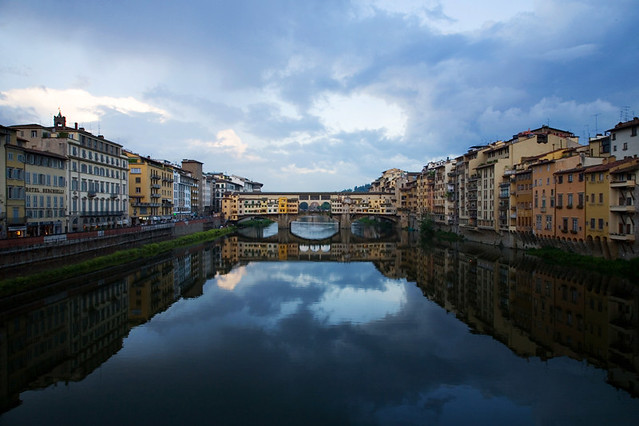
Perhaps no bridge inspires more romantic fantasies than Florence’s Ponte Vecchio. Brightly painted, lined with picturesque shops and paved with cobblestones, this iconic visual treat attracts worldwide admiration. But the bridge is more than beautiful; a close study of its seemingly happenstance layers reveals a remarkable history. The Ponte Vecchio, or the “old bridge,” is the longest standing of the six bridges spanning the Arno River. When the stone-arched base of the current structure was built in 1345, it was considered an architectural marvel. The addition of houses along the bridge, while unexpected today, was commonplace during medieval times.
It wasn’t until 1565 that the bridge received its crowning layer–a long passageway with small, square windows and a red tiled roof. The then-ruler of the city, Duke Cosimo de’ Medici, couldn’t be bothered to commute with common folk from his office (Palazzo Vecchio) to his new home (Palazzo Pitti). Instead, he instructed his in-house architect and artist, Giorgio Vasari, to build a passageway leading from his seat of government, through the Uffizi, over the Ponte Vecchio, past Santa Felicita, and ending on Pitti grounds. The Vasari Corridor, as it came to be called, helped the Duke and his family maintain absolute control of the city as they moved undetected above the crowds.
Only one problem: the Ponte Vecchio’s shops were filled with butchers and tanners. The atrocious smell of slaughter displeased the Medici as it wafted up into the hallway, so they evicted the meat vendors and put goldsmiths in their place. Today, Medici ruthlessness is to thank for the exquisite jewelry box shops adorning the bridge.
The Ponte Vecchio remained relatively the same for almost 400 years, until another despot assumed absolute rule. In 1939, Mussolini installed large windows in the Vasari Corridor over the center of the bridge to impress an international visitor – Hitler. When Mussolini invited Hitler to the secret passageway, however, he was unaware how pivotal his choice of meeting place would be.
Because by 1944, Hitler’s army occupied Florence’s city center, and the Allies were entrenched on the Oltrarno. When the Germans were finally forced to retreat, they decided to destroy all bridges to make it difficult for the Allies to retake the town. The Ponte Vecchio, after standing for centuries, was in imminent danger of total ruin. But, as the story goes, Hitler personally spared the bridge, believing it too beautiful to destroy.
As Florence rebuilt, the Ponte Vecchio became a lasting symbol of heritage and resilience. Today, the singular attraction still draws crowds, but few realize the historic route they walk while suspended above the Arno.

